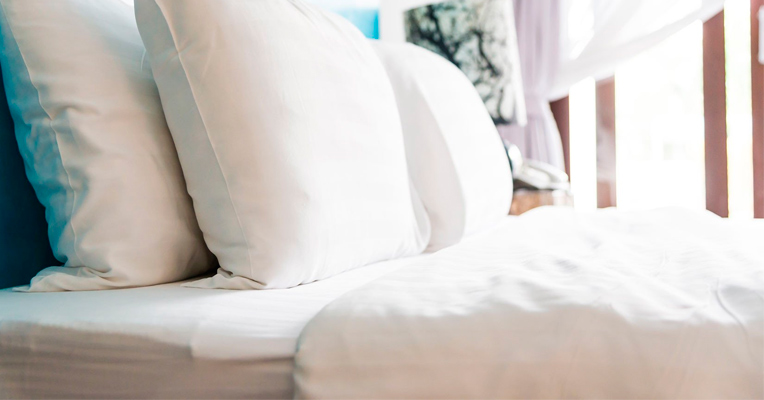The easiest way to hoover a mattress is by using a handheld vacuum. Handheld vacuums are lightweight and maneuverable compared to full-size conventional vacs and can be used for an extended period of time without you tiring your hand. Another alternative is to use an upright vacuum, although most cleaners that are produced today unite the functionality of several devices so that you can use them either preferable way. What's important, though, is that the vac you choose includes an upholstery attachment which you will need for cleaning a foam mattress. Make sure that it's clean. If you spot hair, bits of fabric, or dust on it, remove them with your fingers, then wash the attachment, and let it completely dry out before you start cleaning.
Warning: steam cleaning a memory foam mattress is not a good idea because it may cause mildew and ruin a mattress.
Tip: clean your mattress on the same day as its cover. Most mattress protectors are machine washable and can be put in a normal cycle. Still, it won’t be a waste to check out the label just to make sure you've set up the right temperature.
Any spot needs a cleaning agent to be removed, right? And here, you have several options: 1) to use commercial stain removers or 2) to get stains out of a memory foam mattress by using household ingredients that are always at hand.
- White vinegar and water work wonders when it comes to cleaning coffee, sweat, ink, mildew, etc stains. Mix 1\3 cup vinegar and 3\4 cup water and spray this solution over a dirty spot or all over the mattress if you are making a regular cleanup.
- Baking soda is a good analogue of white vinegar. One tablespoon of baking soda and a tablespoon of salt mixed in cold water is a universal stain remover that can be used virtually for all kinds of stains.
Tip: don’t use hot water because it will cook soda and salt.
- Enzymatic cleaners are very effective and easy to use. You just need to spray them on a stain, wait a couple of minutes, and remove them.
- The fabric cleaner, the one that you entrust your clothes, also does a good job. But with a mattress, it is better to make a soapy solution, because a concentrated cleaner will produce a lot of foam that will be hard to remove by hand. Mix 1\2 cup fabric cleaner and one cup of water.
Tip: to remove a stain without damaging a mattress, use a circular motion and not too much water to work a spot, then dab as much water as you can from a mattress using the dry part of the towel.
You can but you shouldn’t. Since memory foam is made of a soft urethane that has the open cell construction it springs back more slowly and has better saturation than regular foam. This means:
- When the foam gets wet, it becomes too heavy to pick up. So trying to remove moisture, a washing machine may get out of order.
- The foam may tear up during the spin cycle.
- Gel components can be destroyed during a dry cycle because they aren’t resistant to high temperatures.
- The foam may get crumbly after machine wash, in the same way a kitchen sponge does after too many uses.
It does take some time for the foam to dry out, but with the help of several home appliances, you can speed up this process a little.
- For starters, absorb as much water as you can from the top layer of a mattress manually by pressing a clean dry towel on a wet spot.
- A hairdryer works great on small areas. Dry at low temperatures every 2-3 hours to protect the foam from overdrying.
- Baking soda is a good absorbent. Sift it all over the surface and let it absorb moisture for a few hours or overnight. Hoover the mattress afterward.
- If you live in a house and the weather outside is warm, you can dry a mattress in the sun. But don’t forget to place it on a plastic sheet to keep the cover clean.
- If you dry your mattress indoors, provide plenty of air circulation. You can set up a fan on a small stool and direct it at the foam mattress.
Warning: Even if it feels like the mattress is dry, it may still remain damp inside. So in this case haste will only make waste, because mildew may occur inside even a slightly moist mattress and affect your health.
A mattress may have an unpleasant odor after contamination, irregular cleaning and airing, or when it is new. Every new foam mattress has a specific smell that disappears with time. But what about other cases? Well, there is something you can do to enjoy your sleep.
Did you know that baking soda is a great natural deodorant? Yes, that’s right, you can sift it over your mattress, leave it for several hours or better overnight, and vacuum it afterward. Baking soda will absorb all bad odors. And if you add your favorite essential oil, your mattress will smell nice for a long time.
The recipe is simple: mix a cup of baking soda with 15-20 drops of your favorite essential oil in a jar or container with a lid. Then sift the mixture on the mattress. But you already know the procedure, right?
A citrus based cleaner is a good alternative to baking soda. Besides, with such a solution you will kill two birds with one stone: remove stains and unpleasant odors from your mattress.
Tip: you can make your own cleaner. You will need lemon or orange peels, white vinegar, and an airtight container. Mix all the ingredients and let them sit for 2 weeks. Then strain off the peels and fill a spray bottle with the liquid. The natural aromatized cleaner is ready!













